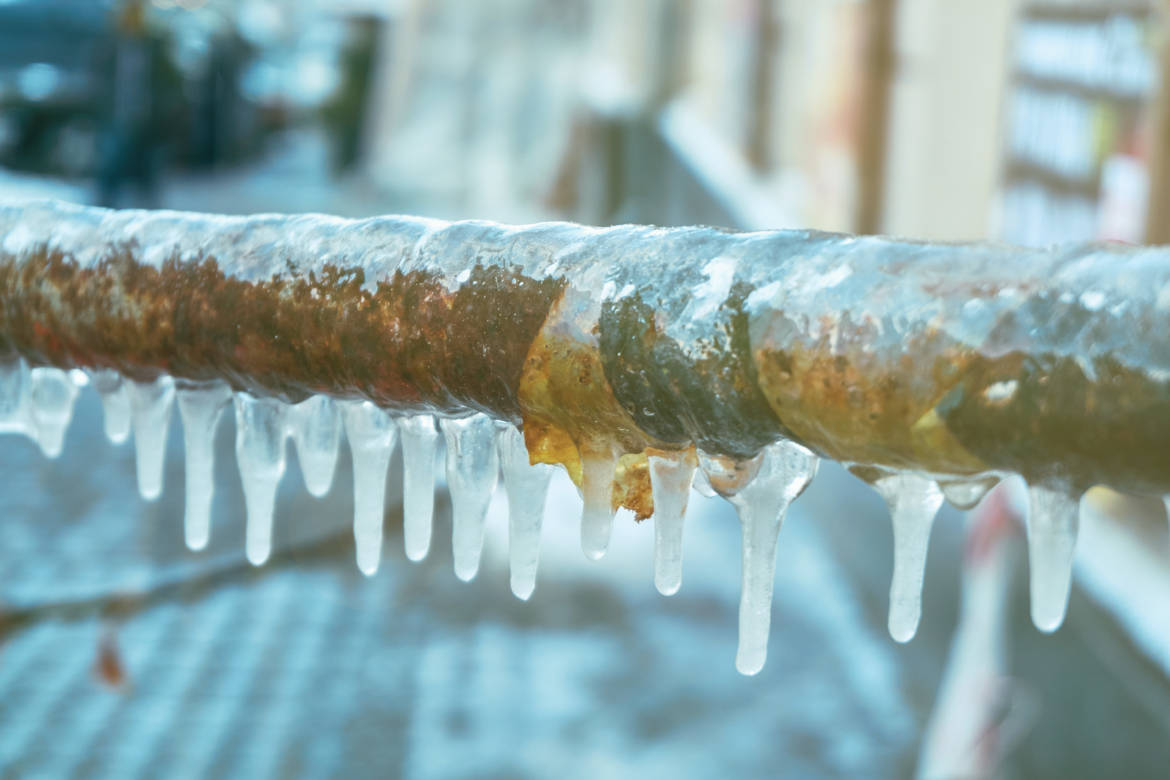Do Frozen Pipes Always Burst?

The short answer is “no.” However, you want to avoid frozen water pipes whenever possible. A burst pipe will not only cause you a lot of trouble, it can cost hundreds or even thousands of dollars to repair the water damage it causes.
But there are many ways to guard against this happening to you. Here is some information about how, when and why pipes burst in cold weather as well as some tips to avoid burst pipes this winter.
If My Pipes are Frozen, Will They Burst?
Water expands as it freezes. When this happens, it can create a blockage in your pipes. This puts incredible pressure on the water between the dam of ice and the closed faucet. Somewhere along the length of pipe between this dam and the faucet will be where it is most likely to burst from the pressure, not from the ice itself.
But, if you take steps to relieve this potential pressure should your efforts to keep your pipes from freezing fail, you can still avoid a burst pipe. So, the answer to the above question is, “not necessarily.” It all depends on whether you get the kind of pressure buildup necessary to cause the pipe to burst. Now, when are your pipes at risk of freezing and possibly bursting?
How Cold Does it Have to be to Burst Pipes?
Water freezes at 32 degrees Fahrenheit. But that doesn’t mean your pipes are in danger of freezing and potentially bursting every time the temperature falls to 32 degrees. A lot depends on where your pipes are located and how much insulation you have on the pipes themselves, as well as in the space around them.
For instance, pipes located in exterior walls, or unheated areas like basements, attics, crawlspaces, and garages are the most susceptible to freezing. Outdoor pipes are also, obviously at risk. Would you believe that holes in your walls where TV cables go out are actually big enough to let a sufficient amount of cold air into the walls to put your pipes at risk of freezing?
Homebuilders in the North build for the cold, insulating their pipes and building them to the interior of their houses to avoid freezing and bursting. However, many homes in the South, where sub-freezing temperatures are not as common, haven’t been constructed this way and may not have sufficient insulation to protect their pipes. Even so, outside temperatures generally have to fall to about 20 degrees Fahrenheit or below before your pipes will freeze or burst due to freezing.
Still, you might not want to wait for temperatures to fall that low before taking precautions to protect your pipes from freezing. Below you will find several tips to avoid burst pipes – some of which you will want to do now, even before the thermostat drops.
How to Avoid Pipes Bursting in Cold Weather
To avoid pipes freezing and potentially bursting in the vulnerable areas of your home, follow the recommendations below.
- Open the cabinet doors under your kitchen and bathroom sinks to allow the warm air in the house to get to the pipes in there and keep them warmer.
- Keep your home a bit warmer than usual during frigid days and nights to help keep your pipes warm too. This may cost you a bit more in utility bills, but it will be worth not having the hassle and expense of a burst pipe. Not only does this keep the pipes in your house warmer, it keeps the floor warmer, which, in turn, keeps the pipes in the crawlspace from freezing.
- Most everyone knows you should let your faucets drip or trickle when the temperature drops below the freezing point to protect your pipes from freezing. But, do you know why it works? By keeping the water in the pipes moving, you make it less likely that it will freeze. Better yet, keeping the faucets open like this prevents the buildup of pressure mentioned earlier. If ice does form and create a blockage, you are less likely to have a burst pipe because the pressure is being released at the faucet end.
- Insulate pipes that are vulnerable to freezing. This can either be done by applying insulation to the pipe itself, or by adding insulation around the pipes. This is especially true when you are concerned about pipes in the attic or basement, places that may not have enough insulation already. While this helps a great deal, it won’t completely prevent the pipes from freezing if they are exposed to prolonged freezing temperatures.
- Seal up all of the cracks, holes and other areas where cold air can get at your pipes from outside. Remember the TV cable?
- If you have rooms in your home that are cooler than others, you may want to use a fan to blow heat into them to protect the pipes in the walls and floors of those areas.
- In fact, you should keep all the doors inside your home open so that heat can spread throughout the house.
- Take your garden hose off your outside faucet and turn off the water to that faucet. Make sure you leave the faucet open to let the rest of the water run out so it won’t freeze and expand inside the faucet.
- You can insulate your outside faucets with anything from a Styrofoam cover, to towels or even newspaper.
- If you can’t or don’t turn off the water to your outside faucets, set them to drip at about 5 drops per minute, 24 hours a day while the temperature outside will be 28 degrees Fahrenheit or below for at least 4 hours.
- Keep your garage door closed to the outside.
- Set your thermostat to the same temperature during the night as you have set it during the day, according to the Red Cross.
What to Do When Your Pipes Burst
Before the winter season is upon you, you should familiarize yourself with every water shut-off valve in your home, especially the location of the main shut-off valve. Know where it is and make sure that it is operational. You may need to shut off the water quickly if things go wrong.
You already know what makes a pipe burst – pressure from water dammed up by ice. Now if a pipe bursts in your home, you could experience severe flooding, which could lead to damaged walls, ceilings, floors, rugs and other personal possessions. So, the first and most important thing you can do is turn off the water at the main shut-off valve as quickly as possible. You need to stop the supply of water coming out through the burst pipe. One burst pipe can discharge four to eight gallons of water every minute so long as it has a supply. That’s a great deal of water.
If the pipe burst in a wall, you may notice a rushing sound in the wall; or, you’ll see water coming out from the baseboards or from the ceiling. If a pipe burst in the basement, of course the floor will get flooded.
With all of this water flowing around, you need to be mindful of electric sockets, wiring and appliances. If you even suspect the water has gotten near any, you need to turn off the electricity too. There’s no reason to take a chance with this. Water and electricity do not mix.
After turning off the water main, you need to stop the leak completely as best you can. You do this by turning on all of the cold faucets in the house until the water stops flowing from them. Also flush the toilets until they do not refill. Next, turn off the water heater and central heat, if they aren’t already off because you shut off the power, and open all of the hot water faucets to drain them as well.
Now, before you clean anything up, document the mess for your insurance company with photos. Then you will want to contact your insurance company as, among other things, they may offer emergency help with advice on how to obtain emergency repair for your burst water pipe. Once you’ve done that, you can start rescuing your valuables, important papers, throw rugs and other personal property. Once that has been done and you’ve gotten the water cleaned up, you may want to hire professionals to dry out your walls, ceilings, floors and/or carpets completely so you don’t get any mold and mildew growth. As you probably know, this can become quite hazardous to your health.
Emergency Repairs for a Burst Water Pipe
If a pipe bursts in your home, there are a few emergency repairs you can do to hold you until you can get a qualified plumber in to fix things. After all, the best way to fix a burst pipe is to replace it. Below are a few quick and easy ways to temporarily patch a burst pipe.
If the hole is bigger than a pinhole, but still relatively small, epoxy putty may be able to plug it.
- Clean and dry the area of pipe to be repaired.
- With gloves on, take prepared epoxy and work it into and around the hole ensuring smooth coverage. Use a putty knife, if necessary.
- Once the epoxy is fully cured and hardened, turn the water back on to check for leaks. Reapply if necessary.
- You can also patch such a hole with a length of rubber from a garden hose, or similar item, and two or three hose clamps.
- Cut the hose so that there are several inches of overlap on either side of the hole.
- Wrap the rubber around the pipe and apply a hose clamp to either side of the hole, and, depending on the size of the hole, one in the middle as well.
- Turn on the water and test for leaks.
- Another method is to use a C-clamp and a block of wood.
- Place a piece of rubber, from a hose or similar item, over the hole.
- Put the block of wood over the rubber. The block of wood causes the pressure from the clamp to be applied evenly to that area of pipe so the pipe won’t collapse.
- Position the screw part of C-clamp against the block of wood.
- Tighten the C-clamp until secure.
- Turn the water back on to check for leaks.
- Lastly, you can use a sleeve clamp to patch small as well as larger holes. This clamp comes in two pieces that wrap the pipe and screw in place over a piece of rubber.
- Purchase a sleeve clamp of a size to fit your particular pipe.
- Place the gasket material that came with the clamp over the hole.
- Put the two sections of the sleeve clamp over the hole and the gasket material.
- Tighten the screws for a secure fit.
- Turn on the water to check for leaks.
Now you know how, when and why pipes burst as well as how to avoid pipes bursting in cold weather. The important take-away here is to know your home and to be prepared as early as possible to protect it against frozen and potentially bursting pipes.




